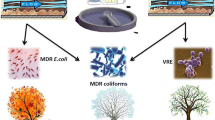Abstract
Coliform bacteria from raw and treated sewage in a mechanical-biological treatment plant were examined for resistance to four to six antibiotics, and randomly selected isolates were identified. The results indicate that certain coliform species are eliminated at lower rates than others by the treatment.Klebsiella sp. became more frequent, whereas the proportion ofEscherichia coli diminished. A comparison of raw and treated sewage clearly reveals that the resistance patterns are transient characteristics, and resistance percentages may either decrease or increase following passage through the treatment plant. Mating of multiresistant isolates withE. coli K12 donor confirmed that some of the resistance traits are borne on conjugative plasmids. Multiple antibiotic resistance (MAR) indexing revealed that resistance levels ofE. coli decreased during waste water treatment, but increased in total coliforms.
Similar content being viewed by others
Literature Cited
Altherr MR, Kasweck KL (1982)In situ studies with membrane diffusion chambers of antibiotic resistance transfer inEscherichia coli. Appl Environ Microbiol 44:838–843
Armstrong JL, Calomiris JJ, Seidler RJ (1982) Selection of antibiotic-resistant standard plate count bacteria during water treatment. Appl Environ Microbiol 44:308–316
Bell JB, Macrae WR, Elliot GE (1981) R Factors in coliform—fecal coliform sewage flora of the prairies and northwest territories of Canada. Appl Environ Microbiol 42: 204–210
Corliss TL, Cohen PS, Cabelli VJ (1981) R-plasmid transfer to and fromEscherichia coli strains isolated from human fecal samples. Appl Environ Microbiol 41:956–966
Fontaine III TD, Hoadley AW (1976) Transferable drug resistance associated with coliforms isolated from hospital and domestic sewage. Health Lab Sci 13:238–245
Gellin G, Langlois BE, Dawson KA, Aaron DK (1989) Antibiotic resistance of Gram-negative enteric bacteria from pigs in three herds with different histories of antibiotic exposure. Appl Environ Microbiol 55:2287–2292
Grabow WOK, Middendorff IG, Prozesky OW (1973) Survival in maturation ponds of coliform bacteria with transferable drug resistance. Water Res 7:1589–1597
Grabow WOK, Prozesky OW, Smith LS (1974) Drug resistant coliforms call for review of water quality standards. Review paper. Water Res 8:1–9
Grassi GG (1977) Clinical aspects of the relationship between antibiotic usage and resistance. J Antimicrob Chemother 3:77–84 (Suppl. C)
Grimes DJ, Atwell RW, Brayton Pr, Palmer LM, Rollins DM, Roszak DB, Singleton FL, Tamplin ML, Colwell RR (1986) The fate of enteric pathogenic bacteria in estuarine and marine environments. Microbiol Sci 3:324–329
Hurst CJ (1991) Presence of enteric viruses in freshwater and their removal by the conventional drinking water treatment process. Bull World Health Orga 69, 1:113–119
Kaspar CW, Burgess JL, Knight IT, Colwell RR (1990) Antibiotic resistance indexing ofEscherichia coli to identify sources of fecal contamination in water. Can J Microbiol 36:891–894
Khalil TA, Gealt MA (1987) Temperature, pH, and cations affect the ability ofEscherichia coli to mobilise plasmids in L broth and synthetic wastewater. Can J Microbiol 33:733–737
Krcmery V jr, Bajizukova A, Langsadl L, Kotuliakova M, Sobotova O (1989) Evaluation of the resistance ofEnterobacteriaceae strains to antibiotics—comparison of strains from clinical material versus environment. J Hyg Epidemiol Microbiol Immunol 33, 3:299–304
Krumperman PH (1983) Multiple antibiotic resistance indexing ofEscherichia coli to identify high-risk sources of fecal contamination of foods. Appl Environ Microbiol 46:165–170
Linton KB, Richmond MH, Bevan R, Gillespie WA (1974) Antibiotic resistance and r factors in coliform bacilli isolated from hospital and domestic sewage. J Med Microbiol 7:91–103
Mach PA, Grimes DJ (1982) R-plasmid transfer in a wastewater treatment plant. Appl Environ Microbiol 44:1395–1403
McClure NC, Fry JC, Weightman AJ (1990) Gene transfer in activated sludge. In: Fry JC, Day MJ (eds) Bacterial genetics in natural environments. London: Chapman and Hall, pp 111–129
McPherson P, Gealt MA (1986) Isolation of indigenous waste-water bacterial strains capable of mobilizing plasmid pBR325. Appl Environ Microbiol 51:904–909
Munro PM, Gauthier MJ, Laumond FM (1987) Changes inEscherichia coli cells starved in seawater or grown in seawater-wastewater mixtures. Appl Environ Microbiol 53: 1476–1481
Murray GE, Tobin RS, Junkins B, Kushner DJ (1984) Effect of chlorination on antibiotic resistance profiles of sewagerelated bacteria. Appl Environ Microbiol 48:73–77
Niemi M, Sibakov M, Niemela S (1983) Antibiotic resistance among different species of fecal coliforms isolated from water samples. Appl Environ Microbiol 45:79–83
Richard C (1984) Genus VIEnterobacter. In: Krieg NR, Holt JG (eds) Bergey's manual of systematic bacteriology. Baltimore/London: Williams & Wilkins Co., pp 465–469
Sambrook J, Fritsch EF, Maniatis T (1989) Molecular cloning: a laboratory manual, 2nd edn. Cold Spring Harbor, N.Y.: Cold Spring Harbor Laboratory Press
Steltzer W, Ziegert E (1988) Das Vorkommen von antibiotikaresistenten Koliformen im Abwasser einer Kläranlage (Occurence of antibiotic-resistant coliforms in waste water of a sewage treatment plant). Zentralbl Mikrobiol 143:415–423
Sørensen SJ (1991) Survival ofEscherichia coli K12 in seawater. FEMS Microbiol Ecol 85:161–168
Trevors JT, Oddie KM (1986) R-plasmid transfer in soil and water. Can J Microbiol 32:610–613
Walter MV, Vennes JW (1985) Occurrence of multiple-antibiotic-resistant enteric bacteria in domestic sewage and oxidation lagoons. Appl Environ Microbiol 50:930–933
Walter MV, Proteous A, Seidler RJ (1987) Measuring genetic stability in bacteria of potential use in genetic engineering. Appl Environ Microbiol 53:105–109
Ørskov I (1984) Genus VKlebsiella. In: Krieg NR, Holt JG (eds) Bergey's manual of systematic bacteriology. Baltimore/London: Williams & Wilkins Co., pp 461–465
Author information
Authors and Affiliations
Rights and permissions
About this article
Cite this article
Andersen, S.R. Effects of waste water treatment on the species composition and Antibiotic resistance of coliform bacteria. Current Microbiology 26, 97–103 (1993). https://doi.org/10.1007/BF01577343
Issue Date:
DOI: https://doi.org/10.1007/BF01577343




